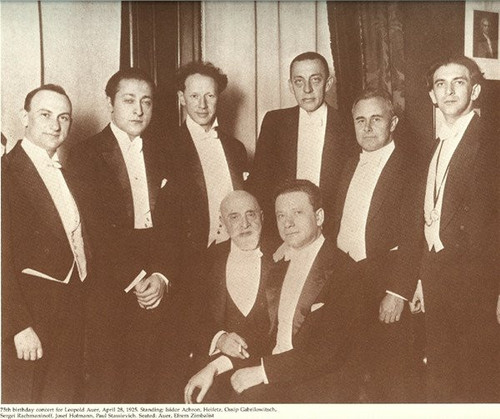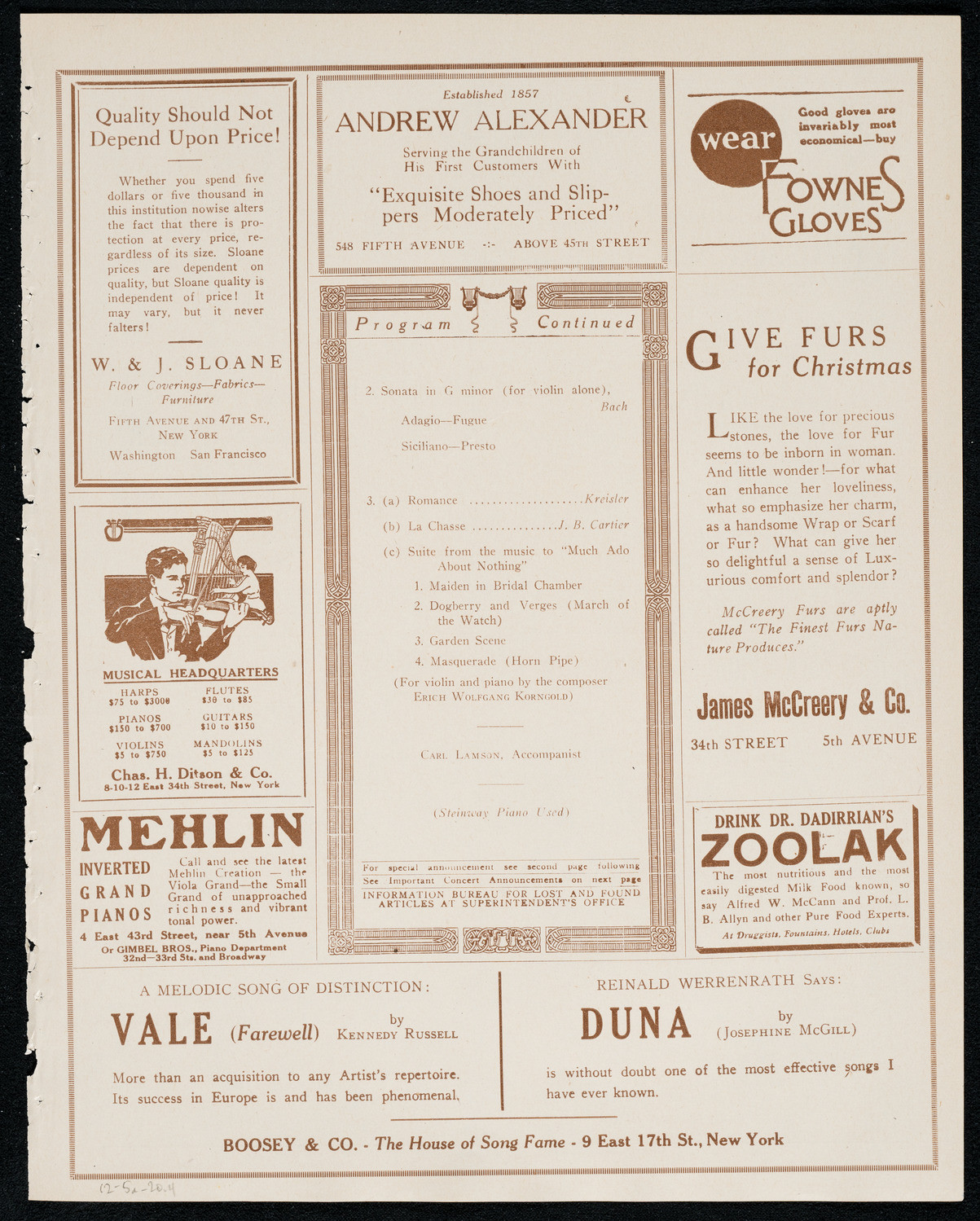Kreisleriana: Fritz Kreisler Rediscovered, Part 3: Rachmaninoff and Korngold arrangements
The turn-of-the-20th century violinist Fritz Kreisler championed music by two of his contemporaries whose names remain familiar to us a century later: Sergei Rachmaninoff (1873-1943) and Erich Korngold (1897-1957). When I put together my Kreisler-inspired recital program, I wanted to be sure to include these works, and here I'd like to present what I found as I researched them.

L-R: Pianist/composer Sergei Rachmaninoff, violinist Fritz Kreisler, composer Erich Korngold.
Sergei Rachmaninoff (1873-1943) is a familiar name in the classical music world - an incredible composer, pianist and conductor. His lush romantic melodies might have felt a little old-fashioned for the time when he composed them, with the early 20th century bringing more contemporary and experimental harmony to the forefront. But then the same could be said for Erich Korngold (1897-1957). Both made their way to America and prospered; and both of their music is programmed with regularity today.
Kreisler and Rachmaninoff
Fritz Kreisler first met Rachmaninoff in 1902, when Rachmaninoff played his own Second Piano Concerto with the Vienna Philharmonic. They developed a life-long relationship despite what seemed like being completely different people. Rachmaninoff was quiet and reserved, while Kreisler was a storyteller. Kreisler loathed practicing - Rachmaninoff had said that "Fritz gives so many concerts that he doesn’t need to practice." Rachmaninoff practiced and worked diligently.
When Rachmaninoff came to the United States after the Russian Revolution, he was known more as a composer of the Prelude in C sharp minor than as a conductor or pianist - but the fastest way to make money was as a touring pianist. Rachmaninoff worked hard at being a concert pianist and eventually became one of the top performers on the circuit.

Standing: Iosif Akhron, Jascha Heifetz, Osip Gabrilovich, Sergei Rachmaninov, Iosif Hoffman, Pavel Stasevich. Sitting: Leopold Auer, Efrem Zimbalist. April 28, 1925
Kreisler and Rachmaninoff made a number of recordings together, and we are lucky to have their recording of three sonatas: Ludwig van Beethoven's Violin Sonata No. 8 in G major, Op. 30 No. 3; Franz Schubert's Violin Sonata in A major; and Edvard Grieg's Sonata for Violin and Piano No. 3 in C minor, Op. 45. My favorite is the Grieg - here is the second movement:
This is breathtaking playing from both players. They obviously respected and adored each other. Rachmaninoff wrote virtuoso treatments of Liebesleid and Liebesfreud for piano and even dedicated his Variations on a Theme of Corelli to Kreisler. Kreisler reciprocated by arranging the Italian Polka, Daisies, and the 18th Variation from the Rhapsody on a Theme by Paganini.
In an article in The Strad (Jan. 1987, p. 48) the violinist Ruggiero Ricci recounted that during the last time he met with Kreisler, Kreisler mentioned that he wanted to transcribe Rachmaninoff's piano concertos for violin. That seems like a large task - one that I’m not sure would make sense. Though if someone were to do it, I assume it would have to be Kreisler.
Obviously he did not get around to transcribing all of Rachmaninoff's piano concertos, but Kreisler did create an arrangement of the second movement of Rachmaninoff's Piano Concerto No. 2. He called it "Preghiera," an Italian word "prayer."
Listening to the Rach 2, it’s a concertante piece where the piano really often times is part of the orchestra. One has to assume that Rachmaninoff was thinking orchestrally, even when writing for the piano. Kreisler's "Preghiera" is not a rarity because it was published and now is available on IMSLP in a lovely new edition by Kenta Hozumi (click here).
What is now available is a newly remastered recording of Kreisler himself playing it - arranged for violin and orchestra. The recording was made for the Bell Telephone Hour and features the Bell Telephone Hour Orchestra, conducted by Donald Voorhees.
In the piano-violin version, Kreisler transposes it to an easier key. He also thins out the piano part somewhat and simplifies the arpeggios. I admit that I was dissatisfied with the one section where Kreisler has the violin play pizzicato - this seems so contrary to the long line.
Strangely in the recording above, Kreisler also eschews the pizzicato for tremolo. I also opted not to do pizzicato, instead switching to a more airy sound and letting the pianist do what the piano does best.
The Groves Dictionary Fifth edition, published in 1954, summarizes Rachmaninoff this way:
"...the enormous popular success some few of Rakhmaninov’s (sic) works had in his lifetime is not likely to last, and musicians never regarded it with much favour. The third pianoforte Concerto was on the whole liked by the public only because of its close resemblance to the second, while the fourth, which attempted something like a new departure, was a failure from the start. The only later work that has attracted large concert audiences was the Rhapsody (variations) on a Theme by Paganini for pianoforte and orchestra."
"Not likely to last"! Some 70 years later, I think it's safe to say: they were wrong.
Kreisler and Erich Korngold
As a child I was unaware of who Erich Korngold was - yet I knew his music indirectly. My dad was a big fan of swashbuckling movies, and I loved watching Errol Flynn in "Robin Hood" - a movie scored by Korngold. What I didn’t understand at that nascent age was the idea of idée fixe and how Korngold gave each main character their own theme. Nor did I realize the debt that the "Star Wars" movie music by John Williams owed to Korngold - have a listen:
Yes, that’s Korngold and not John Williams.
Erich Wolfgang Korngold was a child prodigy who had a flourishing career as a composer in Austria before the rise of the Nazis. He was lucky to have escaped with his family, thanks to a job offer from America - to write the film score for "Robin Hood."
We normally associate Korngold with Jascha Heifetz, since Korngold's Violin Concerto was premiered by Heifetz in 1947 and by now has entered the standard repertoire. Besides the concerto, Korngold wrote a number of other pieces for violin, including incidental music for Shakespeare's "Much Ado About Nothing" and two arias from the opera "Die Tod Stadt."

Program from a December 5, 1920 Carnegie Hall recital: Kreisler performing Korngold’s Suite from Much Ado About Nothing.
The Complete Kreisler Recordings Vol. 6 includes an interesting recording of Kreisler playing Korngold's "Tanzlied des Pierrot" in a modified arrangement. This is an aria from his opera "Die Tote Stadt" (The Dead City), which premiered in 1920 and was an instant hit worldwide, as it dealt with the themes of loss, hope and love that were close to heart of so many people just after World War I.
I of course was entranced by Kreisler's playing of this. He makes every note his own and evokes the sights and sounds of old Vienna in every phrase.
Though there is a published arrangement of this piece that is played by many, it was not what Kreisler played. (I wanted to play exactly what Kreisler played!) To make matters more complicated, this is not just a slight modification, and the manuscript is not in Kreisler's papers. So I asked my friend Paul Levi (who notated the Zoubok Deux's Minutes de Jazz for me) to work his magic and annotate the music. Within a couple of days he had the score to me.
After that, I set to learning the work. I listened to many performances by baritones and found them to be much slower than I wanted to play it. In the sense that in each measure there is a world to be understood and resolved after the enormous loss in the great war, this speed makes sense, but it seemed slow for a violin version.
Kreisler's recording is much faster than recordings of the vocal version - I didn’t know if that was due to the constraints of the 78 rpm time limit or if he really wanted that way. Luckily there also is a recording of Korngold playing it himself at the piano. He does indeed take it at a fast clip. It is, after all, a waltz.
After hearing Korngold's version at the piano, I thought - does any other version matter? We can hear why he was considered a child prodigy and genius. Wonderful piano playing, great touch, elan and freedom.
Will I ever be able to live up to it? As I was recording in my studio, my friend Kuan-Lin Chen looked at us as we went on break and said "TOO FAST!" I pleaded my case….I’m not sure anyone agrees with me. But here it is:
I wish to thank Paul Levi for writing out this wonderful arrangement and to Michelle Kim for playing a blasphemous arrangement of Rachmaninoff and for playing the Korngold above the posted speed limit.
You might also like:
- Kreisleriana: Fritz Kreisler Rediscovered, Part 1
- Kreisleriana: Fritz Kreisler Rediscovered, Part 2: Bach Mozart and Beethoven Reductions
- Kreisleriana: Fritz Kreisler Rediscovered, Part 4: the unpublished 1943 La Campanella
* * *
Enjoying Violinist.com? Click here to sign up for our free, bi-weekly email newsletter. And if you've already signed up, please invite your friends! Thank you.
Replies
You. Made. My. Morning.
Thanks Mr. Shen for the article. It is very interesting. And listening to these little vignettes of Kreisler is wonderful.
Darwin thanks for this marvelous series on Kreisler!
What great stories, all so well pulled together. It reminds me of another story involving those here (I think) details of which I wish I could remember - maybe someone here knows the answer?
Rachmaninoff (maybe) had a tendency to ask his chamber music partners (piano trio) if his compositions were playable. However, he was asking Kreisler (or maybe it was was Heifetz?) and the answer was "sure, it's fine" but in reality it's really difficult!
Does anyone know the cast of players and which piece it was?
At least one story matching your description, Dan. From Herbert Glass for the LA Phil, about Rachmaninoff's Symphonic Dances:
"Interestingly, Rachmaninoff, his performers’ capabilities ever in mind, was in the habit of having an accomplished violinist check the practicability of the bowings for all his works involving strings. For the Symphonic Dances, this function was fulfilled by no less than Fritz Kreisler, Rachmaninoff’s frequent recital partner. Since Kreisler considered no violin part too difficult, the score emerged as music for a virtuoso orchestra."
This article has been archived and is no longer accepting comments.
Violinist.com is made possible by...
Dimitri Musafia, Master Maker of Violin and Viola Cases
International Violin Competition of Indianapolis
Violinist.com Holiday Gift Guide
Johnson String Instrument/Carriage House Violins
Subscribe
Laurie's Books
Discover the best of Violinist.com in these collections of editor Laurie Niles' exclusive interviews.

Violinist.com Interviews Volume 1, with introduction by Hilary Hahn

Violinist.com Interviews Volume 2, with introduction by Rachel Barton Pine








August 26, 2025 at 06:28 AM · Thanks again, Darwin and Michelle: great information and stories, wonderful links and duets!